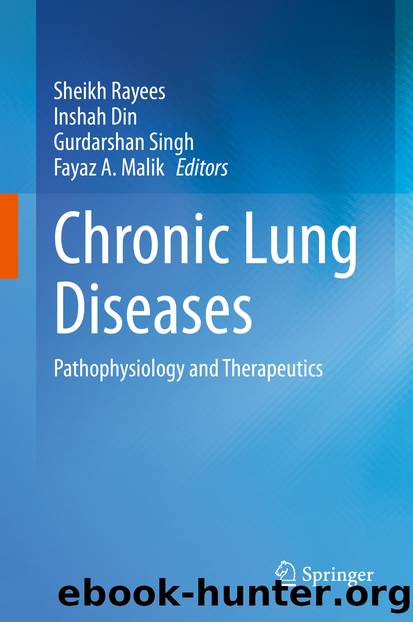Chronic Lung Diseases by Unknown

Author:Unknown
Language: eng
Format: epub
ISBN: 9789811537349
Publisher: Springer Singapore
5.2 Pathophysiology of TB
5.2.1 Biology of the Disease
Mtb is the most common species among all Mycobacterium, which is responsible for TB infection. The bacterial infection is transmitted in the form of droplets having a diameter of 1–5 μm hovering in the air during coughing, speaking, or sneezing of the person with active TB. The environment and extent of exposure, the infectiousness of TB source, and the immune system of an individual are the essential factors that determine the likelihood of transmission of infection to another individual. The airborne infectious droplets come close to the terminal airspaces by inhalation and then infect the alveolar macrophages. Age, intravenous drug administration, recent TB infection, immunodeficiency ensuing from HIV infection, immunosuppressant drugs, and transplantation of organs are the important characteristics allied with an increased risk of progression of active TB. Among all, the strongest acknowledged risk factor for emergent active TB is HIV infection [22]. Patients who undergo tumor necrosis factor-alpha inhibitor therapy are at higher risk of reactivation, and there is a continuous need to access TB in these patients by radiologist. Diabetes mellitus, chronic renal failure, silicosis, low body weight, alcohol or tobacco abuse, prior gastrectomy or jejunoileal bypass, and malignancies like leukemia, head, neck, and lung carcinoma are the conditions that augment the risk of active TB [38].
The word “Granuloma” was first used by Rudolph Virchow in 1818 to illustrate tumor that ulcerate and give rise to granulation tissue [39, 40]. It is defined as the assortment of inflammatory cells dominated by mononuclear cells and also involves a large figure of enzymes and cytokines [41]. Imperative research precedence is interpreting the underlying mechanism involving granulomas maintenance, which is associated with control of infection and persistence of the Mtb [42]. From host viewpoint, granuloma has the ability to wall off contagion from the body, so-called bacterial prison. From bacterial viewpoint, it is an increasing assortment of phagocytic cells to transmit disease and multiply inside the host. The recruitment of developing granuloma of myeloid cells is highly permissive to Mtb infection due to secretion system ESX-1 from the region of difference 1 (RD-1) that initiates the type-1 interferon response [43]. RD1 contains genes of bacterial secretion system ESX-1, which is responsible for the release of bacterial product into the cytoplasm of macrophages when bacteria undergo phagocytosis [44]. This secretion system plays a vital role in the pathogenesis of active TB. A few non-TB mycobacteria like Mycobacterium kansasii and Mycobacterium marinum also possess a conserved ESX-1 antigen that has encouraged a reconsideration of the ability of ESX-1 in the virulence of Mtb [45]. So, it is necessary to consider but not exclusively liable for the virulence of Mtb [46]. Immune responses are segregated in the region of the granulomas having proinflammatory cells constituent at its center and anti-inflammatory in neighboring tissue [47]. Granuloma shows some extent of variation in its pattern of organization. The essential constituents of granulomas are macrophages, which are predominated centrally, and their function is to remove the pathogen via phagocytosis.
Download
This site does not store any files on its server. We only index and link to content provided by other sites. Please contact the content providers to delete copyright contents if any and email us, we'll remove relevant links or contents immediately.
Still Foolin’ ’Em by Billy Crystal(36301)
We're Going to Need More Wine by Gabrielle Union(18997)
Plagued by Fire by Paul Hendrickson(17367)
Pimp by Iceberg Slim(14433)
Molly's Game by Molly Bloom(14101)
Becoming by Michelle Obama(9971)
When Breath Becomes Air by Paul Kalanithi(8363)
Educated by Tara Westover(7994)
The Girl Without a Voice by Casey Watson(7842)
Note to Self by Connor Franta(7643)
The Incest Diary by Anonymous(7629)
How to Be a Bawse: A Guide to Conquering Life by Lilly Singh(7426)
The Space Between by Michelle L. Teichman(6890)
What Does This Button Do? by Bruce Dickinson(6164)
Imperfect by Sanjay Manjrekar(5833)
Permanent Record by Edward Snowden(5793)
A Year in the Merde by Stephen Clarke(5366)
Shoe Dog by Phil Knight(5215)
Promise Me, Dad by Joe Biden(5110)
